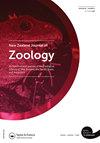环境DNA作为监测南极脊椎动物的工具
IF 1.1
4区 生物学
Q3 ZOOLOGY
引用次数: 7
摘要
南极洲是许多易受环境变化影响的物种的栖息地,评估物种的反应需要长期监测。然而,南极洲的极端性质限制了进行了解群落组成变化所必需的那种长期或大规模的研究。在本文中,我们评估了环境DNA (eDNA)方法在扩大南极洲生物多样性监测和保护遗传学的科学研究工作中的潜力。通过系统的文献回顾,我们发现大多数南极eDNA研究都集中在微生物元条形码上,使用了来自土壤、沉积物、雪和水的样本。在南极洲,很少有eDNA研究关注脊椎动物的生物多样性或种群遗传学,但我们强调了几个有效和创造性地使用eDNA研究脊椎动物的例子。我们强调了便携式测序技术在未来南极eDNA研究中的应用潜力。我们得出结论,eDNA可以成为研究人员评估、监测和保护南极生物多样性的一个有价值的工具。本文章由计算机程序翻译,如有差异,请以英文原文为准。
Environmental DNA as a tool for monitoring Antarctic vertebrates
ABSTRACT Antarctica is home to numerous species that are vulnerable to environmental change, and assessing species responses requires long-term monitoring. However, Antarctica’s extreme nature presents limitations to conducting the type of long-term or broad-scale studies necessary for understanding changes in community composition. In this paper, we evaluate the potential for the use of environmental DNA (eDNA) methods in expanding scientific research efforts for biodiversity monitoring and conservation genetics in Antarctica. Through a systematic literature review, we identify that most Antarctic eDNA studies have focused on microbial metabarcoding using samples from soil, sediment, snow, and water. Few eDNA studies in Antarctica have focused on vertebrate biodiversity or population genetics, but we highlight several examples that have effectively and creatively used eDNA to study vertebrates. We highlight the potential for the use of portable sequencing technologies in the future of Antarctic eDNA research. We conclude that eDNA could be a valuable tool for researchers in their efforts to assess, monitor, and conserve biodiversity in the Antarctic.
求助全文
通过发布文献求助,成功后即可免费获取论文全文。
去求助
来源期刊
CiteScore
2.80
自引率
0.00%
发文量
20
审稿时长
>12 weeks
期刊介绍:
Aims: The diversity of the fauna of the southern continents and oceans is of worldwide interest to researchers in universities, museums, and other centres. The New Zealand Journal of Zoology plays an important role in disseminating information on field-based, experimental, and theoretical research on the zoology of the region.

 求助内容:
求助内容: 应助结果提醒方式:
应助结果提醒方式:


